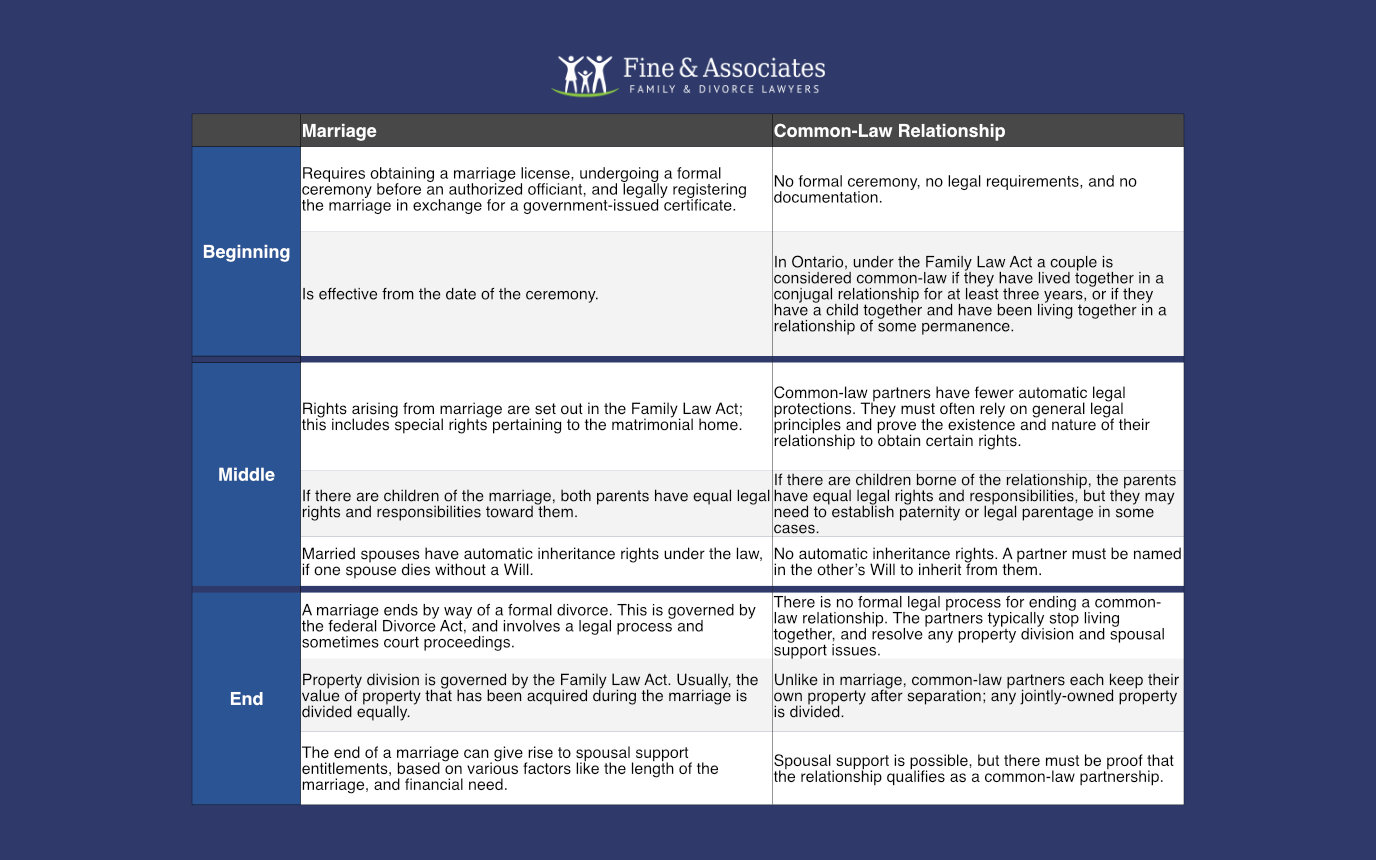
Marriage Versus Common-Law in Ontario – What’s the Difference?
According to the latest reports by Statistics Canada, marriage rates have been on the decline in the past few years, while common-law relationships have been on the rise. This ebb and flow in the popularity of each is due to many factors, of course. But at least some of them relate to the differences between each type of relationship union.
MARRIAGE
Beginning
- Requires obtaining a marriage license, undergoing a formal ceremony before an authorized officiant, and legally registering the marriage in exchange for a government-issued certificate.
- Is effective from the date of the ceremony.
Middle
- Rights arising from marriage are set out in the Family Law Act; this includes special rights pertaining to the matrimonial home.
- If there are children of the marriage, both parents have equal legal rights and responsibilities toward them.
- Married spouses have automatic inheritance rights under the law, if one spouse dies without a Will.
End
- A marriage ends by way of a formal divorce. This is governed by the federal Divorce Act, and involves a legal process and sometimes court proceedings.
- Property division is governed by the Family Law Act. Usually, the value of property that has been acquired during the marriage is divided equally.
- The end of a marriage can give rise to spousal support entitlements, based on various factors like the length of the marriage, and financial need.
COMMON-LAW RELATIONSHIP
Beginning
- No formal ceremony, no legal requirements, and no documentation.
- In Ontario, under the Family Law Act a couple is considered common-law if they have lived together in a conjugal relationship for at least three years, or if they have a child together and have been living together in a relationship of some permanence.
Middle
- Common-law partners have fewer automatic legal protections. They must often rely on general legal principles and prove the existence and nature of their relationship to obtain certain rights.
- If there are children borne of the relationship, the parents have equal legal rights and responsibilities, but they may need to establish paternity or legal parentage in some cases.
- No automatic inheritance rights. A partner must be named in the other’s Will to inherit from them.
End
- There is no formal legal process for ending a common-law relationship. The partners typically stop living together, and resolve any property division and spousal support issues.
- Unlike in marriage, common-law partners each keep their own property after separation; any jointly-owned property is divided.
- Spousal support is possible, but there must be proof that the relationship qualifies as a common-law partnership.
Refer to the table below for a side-by-side comparison of both types of relationship unions.

Conclusion
As this comparison reveals, being married in Ontario versus being in a common-law relationship will give rise to similar legal rights and responsibilities, but they also differ in significant respects. Marriage tends to offer not just a formal recognition of the relationship but added legal protections as well.
These protections include more straightforward processes for property division, spousal support, and inheritance rights. Common-law relationships, while offering flexibility and a more informal approach to partnership, often require additional steps to establish legal rights and can result in more complex legal scenarios upon separation. This means that if you’re in a common-law relationship, you may have to take extra steps to protect your rights. Feel free to give our offices a call, to discuss your options.
Related Articles
- I Am in a Common Law Relationship: What are my Property Rights?
- Does a Common Law Marriage Require a Divorce?
- How is Property Divided Between Spouses?
